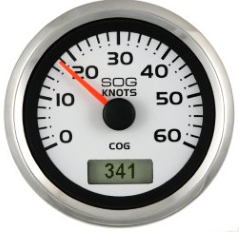GPS Speedometer: Difference between revisions
| Line 20: | Line 20: | ||
'''[http://www.neweagle.net/support/wiki/docs/CAD_drawings/VeeThree/gps_speedometer.pdf GPS Speedometer CAD Drawing]''' | '''[http://www.neweagle.net/support/wiki/docs/CAD_drawings/VeeThree/gps_speedometer.pdf GPS Speedometer CAD Drawing]''' | ||
'''[http://www.neweagle.net/support/wiki/docs/CAD_drawings/VeeThree/69055_R1.pdf Assembly, Receiver, High Speed GPS Speedometer, Cable Drawing]''' | |||
==More Products by Veethree == | ==More Products by Veethree == | ||
Revision as of 14:56, 13 September 2011
GPS Speedometer
A GPS Speedometer is an instrument designed to provide accurate ground speed and headings all within an attractive package. It is available in various speed ranges and color schemes to fit your particular application. The GPS Speedometer can be connected to an existing NMEA0183 receiver, or you can purchase one specifically for use with it. The GPS technology in use makes this an appropriate product for any application, but especially low and high speed watercraft where in-water speed pickups like pitot tubes and paddle wheels do not work well.

- Features include:
- Available in speed ranges of 35 MPH, 60 MPH, 30 knots, and 60 knots
- Included LCD heading display to show heading
- Use our GPS receiver or any NMEA0183 receiver (NMEA2000 support coming soon)
- Speed accuracy of +/- 1 MPH once moving
- Heading accuracy of +/- 1 degree once moving
- Ideal for low speed or high speed craft where traditional speed measuring devices do not work well
- Custom styles and speed ranges available
GPS Speedometer Antenna Emplacement
There is no hard and fast rule for the placement of the GPS antenna; though it is recommended that the antenna can see the sky, preferably on the outside of the vehicle. However, it is possible to place the antenna in an enclosed area such as a glove box, car trunk, under a fiberglass dash, or other enclosed spaces. But it is not guaranteed the antenna will work in these locations. Whether the antenna works or not would be unique to the application, specifically if something in the structure is interfering with the incoming transmission. So if it is desired to place the antenna in enclosed location, first test it by placing the antenna in the location and to check the incoming signal strength. If a signal is received and the GPS is working well than it should be okay to use in that location and you can permanently affix the antenna. Just note that a few antenna locations may need to be tested before a useable one is found.
Datasheet
Assembly, Receiver, High Speed GPS Speedometer, Cable Drawing
More Products by Veethree
More Information: Veethree Instruments